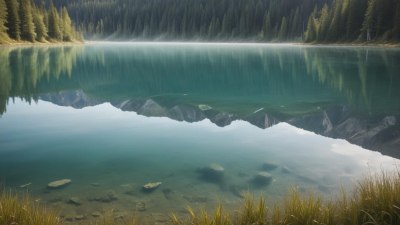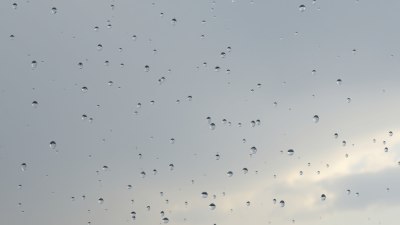Why Lakes Are Either Crystal Clear or a Mystery Soup with No In-Between
Explore the fascinating reasons behind the contrasting clarity of lakes, from crystal clear waters to murky mystery soups.

This image was created with the assistance of Freepik
Lakes are one of nature's most beautiful features, often characterized by their tranquil surfaces and vibrant ecosystems. However, if you observe a selection of lakes, you'll notice there’s a distinctive divide between those that boast crystal clear waters and those that resemble murky, mysterious soups. This phenomenon raises intriguing questions about water quality, aquatic life, and environmental impact. In this article, we delve into the factors that contribute to the stark contrast in lake clarity, examining the underlying science behind the alchemy of lake waters.
The Science of Clarity
To understand why some lakes are crystal clear while others are murky, we need to delve into the science of water clarity. Water clarity is determined by the amount of light that penetrates the water column, which can be influenced by sediment, algae, and other organic materials suspended in the water. Clear lakes allow light to penetrate deeper, enabling aquatic plants and photosynthetic organisms to thrive. In contrast, murky lakes have high levels of suspended particles, reducing light penetration and ultimately affecting the entire ecosystem.
Causes of Crystal Clear Lakes
There are several factors that contribute to the clarity of lakes. Crystal clear lakes typically exhibit low nutrient levels, which minimizes the growth of algae and vegetation. One primary reason for the clarity is the lake's geological characteristics. Lakes formed in glacial regions often have sandy or rocky bottoms that prevent sediment disturbance, thereby maintaining clarity. Additionally, the presence of filter-feeding organisms, such as zooplankton, can help keep these lakes clear by consuming algae and organic particles.
Role of Watersheds
The surrounding watershed plays a critical role in determining the clarity of a lake. A healthy watershed with minimal human impact can significantly enhance water quality. Forested or natural landscapes help filter pollutants from runoff, while impervious surfaces like asphalt and concrete can introduce sediments and nutrients that promote algal blooms. Healthy watersheds contribute to fewer disturbances and better buffering against pollution, leading to cleaner, clearer lake waters.
Natural Filtration Processes
In many cases, crystal clear lakes undergo natural filtration processes. These processes can include the action of plants and sediments to capture and bind particles. For instance, rooted aquatic plants stabilize sediment and provide habitat for microorganisms that break down organic matter. Similarly, wetlands and marshes near lake shores can act as natural filters, absorbing excess nutrients before they reach the lake. This natural filtration is crucial for maintaining water clarity and overall ecological health.
Influence of Temperature and Strata
Temperature plays a pivotal role in the layering of lake waters, known as stratification. In the warmer months, lakes usually stratify into layers: the warmer surface layer, known as the epilimnion, and the cooler bottom layer, the hypolimnion. In crystal clear lakes, these layers are stable, and nutrients remain locked at the bottom, minimizing algae growth. However, in deeper lakes or those experiencing thermocline disruption, warmer surface waters can stir up nutrients, feeding algal blooms and leading to murky conditions.
Temporary Algal Blooms
Even in relatively clear lakes, temporary algal blooms can occur due to shifts in nutrient levels, temperature changes, or sudden influxes of pollutants. These blooms can create murky or soupy conditions even in previously clear waters. Monitoring and managing nutrient levels, particularly in lake watersheds, becomes crucial to prevent excessive algal growth. Nutrient loading, particularly nitrogen and phosphorus from agricultural runoff, is one of the leading causes of these blooms.
Human Impact and Pollution
Human activities significantly impact lake clarity. Urbanization, agriculture, and industrial activities introduce various pollutants into nearby lakes, disrupting their natural balance. Runoff containing fertilizers, detergents, and sediments can lead to increased nutrient levels, causing algal blooms and murky waters. Additionally, activities such as boating and shoreline development can disturb sediments and contribute to increased turbidity. Sustainable land management practices and regulations can play a vital role in protecting lake health and clarity.
Examples of Notable Lakes
Several lakes worldwide exemplify the extremes of clarity. Crater Lake in Oregon, USA, is renowned for its stunning clarity, attributable to its deep, clear waters formed in a caldera with minimal nutrient inflow. On the opposite end of the spectrum, Lake Erie has faced significant challenges with algae blooms, partly due to agricultural runoff. These contrasting examples highlight the delicate balance affecting lake ecosystems and the ongoing need for conservation efforts.
Conservation Efforts and Solutions
To mitigate the issues of murky lakes and protect crystal clear waters, various conservation efforts can be implemented. These include promoting sustainable land practices, reducing nutrient runoff, and increasing public awareness about the importance of maintaining lake health. Restoration projects, including wetland preservation and reforestation, can enhance natural filtration and buffer zones, improving water clarity. Effective regulations and partnerships among stakeholders can also play a critical role in ensuring lakes retain their natural beauty.
In conclusion, the stark divide between crystal clear lakes and murky mystery soups can be attributed to a complex interplay of natural and anthropogenic factors. Understanding these elements is crucial for the preservation of lakes and their ecosystems. From the natural filtration processes and healthy watersheds to the impacts of human activities, maintaining the balance of lake ecosystems is vital for sustaining their beauty and ecological health. As we continue to explore and enjoy these natural wonders, it's essential to adopt practices that promote clarity and long-term preservation, ensuring future generations can also experience their magnificence.











